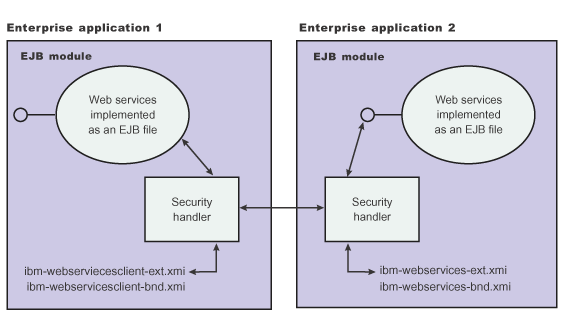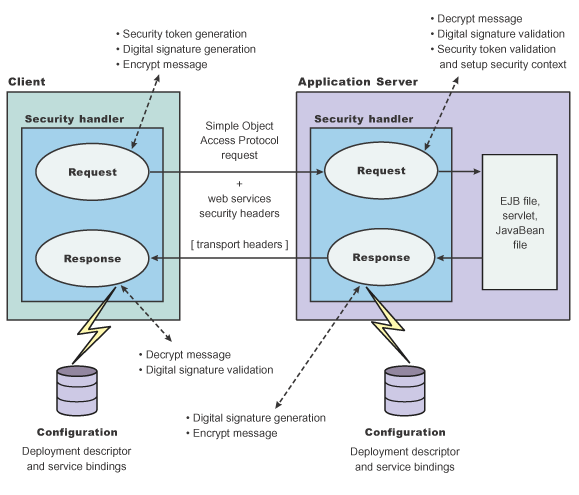![[Version 5 only]](../../v5app.gif)
![[Version 5 only]](../../v5app.gif)
The Web services security model used by WebSphere Application Server is the declarative model. WebSphere Application Server does not include any application programming interfaces (APIs) for programmatically interacting with Web services security. However, a few Server Provider Interfaces (SPIs) are available for extending some security-related behaviors.
Important distinction between Version 5.x and Version 6 applications
Note: The information in this article supports version 5.x applications only that are used with WebSphere Application Server Version 6. The information does not apply to version 6 applications.
Figure 1.
Web services security model  The security constraints for Web services security are specified in IBM
deployment descriptor extensions for Web services. The Web services security run time acts on the constraints to enforce Web services security for the Simple Object Access Protocol (SOAP) message. The scope of the IBM deployment descriptor extension is at the enterprise bean (EJB) or Web module level.
Bindings are associated with each of the following IBM deployment descriptor extensions:
The security constraints for Web services security are specified in IBM
deployment descriptor extensions for Web services. The Web services security run time acts on the constraints to enforce Web services security for the Simple Object Access Protocol (SOAP) message. The scope of the IBM deployment descriptor extension is at the enterprise bean (EJB) or Web module level.
Bindings are associated with each of the following IBM deployment descriptor extensions:
IBM recommends that you use the tools provided by IBM (the Application Server Toolkit and Rational Web Developer) to create the IBM deployment descriptor extension and bindings. After the bindings are created, you can use the administrative console or an assembly tool to specify the bindings.
Important
Note: The binding information is collected after application deployment rather than during application deployment. The alternative is to specify the required binding information before deploying your application.
Figure 1.
Web services security message interpretation  The Web services security run time enforces Web services security based on the defined security constraints in the deployment descriptor and binding files. Web services security has the following four points where it intercepts the message and acts on the security constraints defined:
The Web services security run time enforces Web services security based on the defined security constraints in the deployment descriptor and binding files. Web services security has the following four points where it intercepts the message and acts on the security constraints defined:
| Message points | Description |
|---|---|
| Request sender (defined in the ibm-webservicesclient-ext.xmi and ibm-webservicesclient-bnd.xmi files) |
|
| Request receiver (defined in the ibm-webservices-ext.xmi and ibm-webservices-bnd.xmi files) |
|
| Response sender (defined in the ibm-webservices-ext.xmi and ibm-webservices-bnd.xmi files) |
|
| Response receiver (defined in the ibm-webservicesclient-ext.xmi or ibm-webservicesclient-bnd.xmi files) |
|
Related concepts
Web services security specification-a chronology
Web services security and Java 2 Platform, Enterprise Edition security relationship
Related reference
Web services security support